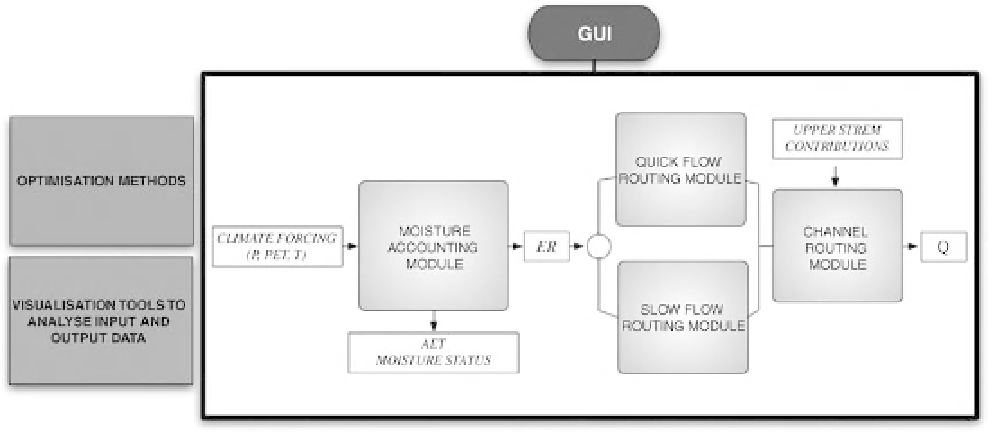Environmental Engineering Reference
In-Depth Information
rainfall (ER), actual evapotranspiration (AET) and
an estimation of moisture status; the routing
module calculates the fast and slow runoff; and
the channel routing module estimates discharge
at the outlet of the sub-area. The formulation of
the first two modules is based on the established
RRMT framework (Wagener et al. 2004). A variety
of pre-built modules are available, which are in-
terchangeable, but others can be added providing
additional flexibility.
The toolbox allows for different optimization
methods for calibration: uniform random
search, the shuffled complex evolution method
(Duan et al. 1993), and local non-linear multi-
constrained methods based on simplex search-
ing. These methods can be applied with the
same or different model structures representing
the individual sub-areas. The input data and
simulated variables in every sub-area can be
analysed using a variety of visualization tools.
This semi-distributed rainfall-runoff model is
used to route water from field-scale hydrological
response units to and along the streams and
ditches identified within the catchment. Fields
were chosen as the individual response units be-
cause these seeman appropriatemanagement unit
when looking at the influence of land use changes.
within the catchment model to take account of
small-scale data uncertainty and metamodel
uncertainty.
Catchment-scale simulations
The semi-distributed rainfall-runoff modelling
toolbox RRMTSD (Orellana et al. 2008) is a mod-
ular framework that allows efficient building
and evaluation of semi-distributed rainfall-runoff
models (Fig. 3.10). These models are semi-distrib-
uted in the sense that the watershed is conceptu-
alized as a network of sub-areas for which lumped
conceptual rainfall-runoff models are computed.
The hydrological processes and climatological
forcing data within the sub-areas are considered to
be homogeneous, and the degree of spatial distri-
bution is represented mainly through the number
of sub-areas. These can represent subcatchments
or hydrological response units, and can incorporate
the metamodel structures discussed above.
Topologically, RRMTSD simulates streamflow
for the uppermost stream sub-areas first and then
continues with the downstream ones. The archi-
tecture comprises three component modules:
moisture accounting, runoff routing and channel
routing. The first module determines effective
Fig. 3.10
Structure of Semi-Distributed Rainfall-Runoff Modelling Toolbox (RRMT-SD). P, precipitation; PET,
potential evaporation; T, temperature; AET, actual evaporation; ER, effective rainfall; Q, discharge.

